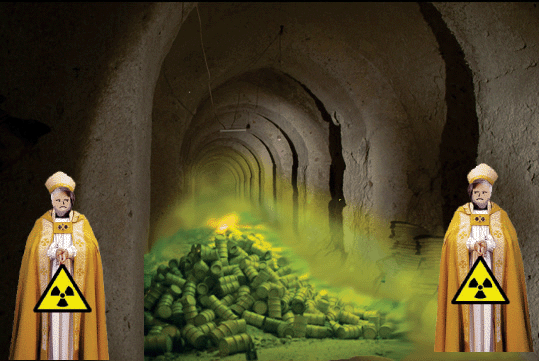As the world increasingly buries its nuclear waste, a growing number of experts are trying to come up with a way to warn future generations of what, exactly, will be lying under their feet. Deciding where to create nuclear waste storage sites, demarcating them clearly and then writing it all down seems like the obvious solution. After all, mankind started writing down its history 5,500 years ago and the likelihood of us stopping to do so seems slim. But the question then becomes: what should we write this crucial piece of information on? Stone and paper deteriorate. USB sticks and servers do, too. Some government entities, like ANDRA, the French National Agency in charge of managing radioactive waste, have started to record their archive on permanent paper. Also known as acid-free paper due to its composition, it can remain chemically and physically stable for a long period of time — unlike traditional paper, which starts to yellow and decay over time when exposed to light or heat.
The agency has also built sapphire discs, made out of sapphire and etched with platinum on one side. These can contain up to 40,000 pages of pictures and text and could, theoretically, last for some two million years. Language, after all, is a living, changing entity. That’s why it took us decades to decode Egyptian hieroglyphs and why you might have gotten a headache reading Shakespeare’s Old English masterpieces in class. So who’s to say that French scientists 1,000 years from now will be able to understand la langue de Moliere’s current form? The OECD’s Nuclear Energy Agency (NEA) has since created a working group whose task it is to set the best practices on Radioactive Waste Repository Metadata Management so that all the information is not only stored properly but is also easily accessible as national nuclear waste programmes evolve…
In a report, the researchers led by Thomas Sebeok of the University of Indiana recommended the creation of a nuclear priesthood, inspired by the Catholic Church, which would relay information down the generations through “a mixture of iconic, indexical and symbolic elements” and “a high degree of redundancy of messages.”..
The problem with art, explained Peter Galison, professor of the History of Science and of Physics at Harvard University and author of the Containment documentary, is that if a message is too artistic, then it might not be properly understood as different people may have different interpretations of it….For instance, you know for sure what the skull pictogram means. If you’re thinking death, you’re right. Yet this symbol, Blanquer said, “comes from alchemists.” “The skull represents Adam and the crossing bones the promise of resurrection,” he revealed. So in the span of just a few centuries this particular pictogram has evolved from meaning resurrection to meaning death.
As waste can be buried either near or deep under the surface, the signal should be seen both above but also under the ground. The researchers employed by the US Department of Energy in the mid-1980s (who came up with the nuclear priesthood, remember!), had also envisioned different monuments to get the point across: fields of pikes, threatening statues of thunderbolts, or enormous blocs of granite positioned into a tight grid….
The Finnish project of Onkalo took the problem completely differently: what if we came up with a way that would allow us to simply not tell future generations? Its solution? Digging a deep geological repository for spent nuclear fuel. “The entire concept of Posiva (the company which manages the project), is that 100 to 120 years after it’s been closed, the site will not be signalled. The 500 meters to the storage site in the geological layer will be filled with rock and the entire thing will be isolated and invisible in the natural landscape.”
Excerpts from What will a nuclear waste warning look like in 100,000 years’ time?, Euronews, Nov. 16, 2018
